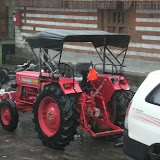THE FOLLOWING STORY IS A CONCISE VERSION OF MY ADVENTURES IN LADAKH.
THE BLOG POSTS THAT FOLLOW ILLUSTRATE THE STORY A WEE BIT MORE ~
Ladakh is a semi autonomous area in the region of Jammu and Kashmir in Northern India. I travelled there to stay with a local family in their home and participate in their way of life.
To get there, I crossed Taglang La, which at 5,359m (17,684ft) is the second highest pass in the world.
I arrived in Takmachik and met my lovely family on the 3 August 2010. There are four generations living in the one house. The oldest is Phutsok Dorge at 90 years, and the youngest - and wildest is Jigmet Chopel at two and a half years.
I believe that life in Ladakh is similar to the way life was in Islay and Colonsay at the time when my Dad was a wee boy. The people grow their own food. There is not a predominant money economy. In the villages there are no shops to speak of - if you don't work and create the food yourself, you will go hungry. For me, the difference between Islay and Ladakh is not specifically one of geography, but one of time.
I helped the family harvest apricots, turn the daal, fetch water, brush the floors with appropriate grass brushes. Life was peaceful, deep, hard working, joyous. Until the rain started. Heavy rain is unheard of in Ladakh. The annual rainfall is 90mm. This summer it poured for days. The roofs of the houses leaked, the apricots drying in the sun were ruined, the daal drying on the rooftops was soggy and turning mouldy.
One night we heard shouting, everyone had to move to high ground. The river that serviced the village had swelled to become a huge, raging torrent. It had burst it's banks, carrying fields and animals with it , and was now heading for the village.
I ran along a high ridge of rock. Looking down, it was like a mini tsunami, everything just crumpled before the awesome power of water. Fully grown trees snapped like dry matchsticks. The huge stone road bridge was swept away in an instant. Nothing could have held against the overwhelming weight of the water. It had found it's way from the mountains to the Indus. That night, and for three nights after, we all slept in a concrete built community centre up on a ledge on the mountainside.
Our village was now cut off from the outside world. Luckily, people could still walk out over a pedestrian bridge. We heard news of the terrible floods in Leh, 700 missing, five road bridges swept away. The village next to ours had lost 20 souls. There was not much to do to help our villagers. Their fields had been swept away, we were eating their food supplies, there was only one hand pump to supply all our water requirements. There were no communication links to the outside world. Our families in the UK didn't know if we were alive or dead.
Time to leave, I thought. I packed a small haversack with my sleeping bag, a first aid kit, a warm jumper, my diary, and my toothbrush and like India Anna Jones, set off. It was a bit scarey, but it was better to be actively doing something, than waiting to be rescued.
I crossed ravines by tree trunks lashed together, by metal step ladders placed over the stones on each side of the torrents. I got lifts in the back of huge stone dumper lorries. I also got a lift from a colonel in the army, who gave me an apple and whisked me along the burst banks of the Indus to Leh.
On arrival in Leh, I delivered a hand written letter to the Lama son of my Ladakhi family, informing him they were all safe. I waited at the airport for six hours for a standby seat to Delhi. In Delhi, I bought the last available ticket to the UK, and slept in the airport until my flight was called.
Before I left, both the grandmother and the grandfather of my Takmachik family put silk scarves around my neck. They were to keep me safe on my journey. I arrived at Heathrow, took the first train to Glasgow, then got the ferry to Islay.
And when I was safely back in my own home, I took off the scarves.
